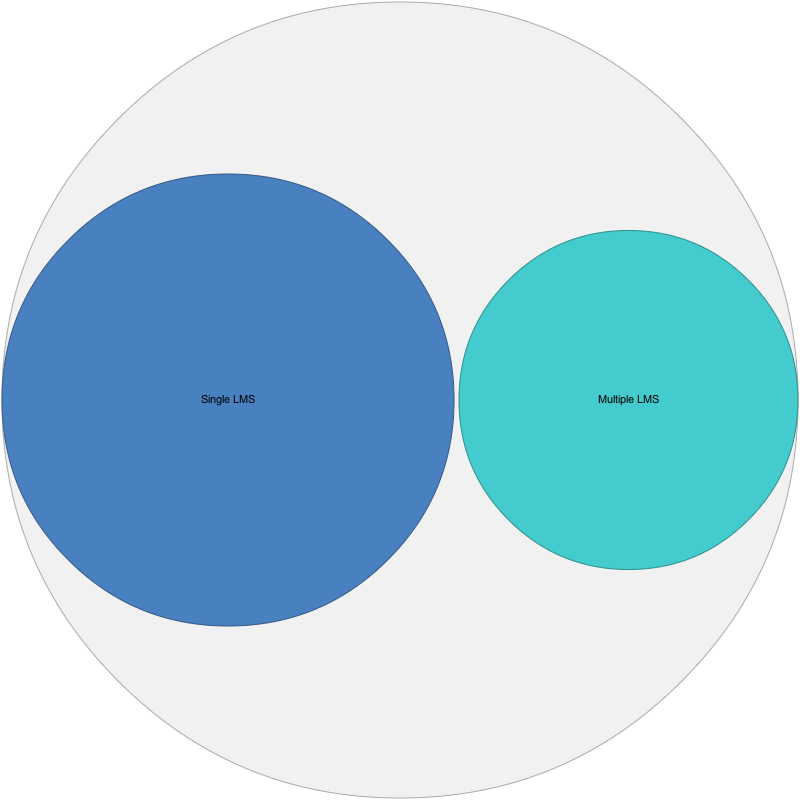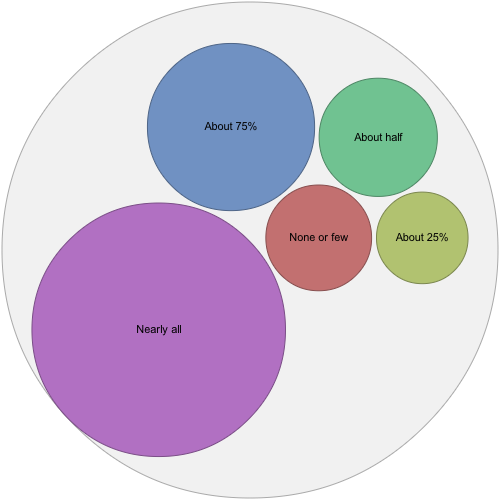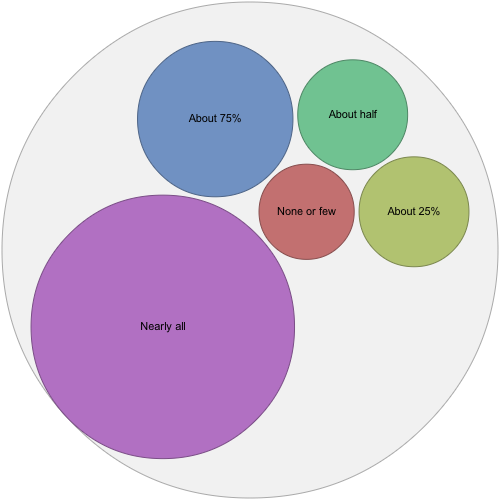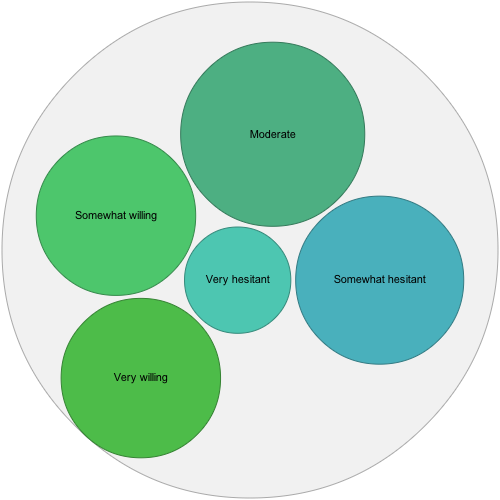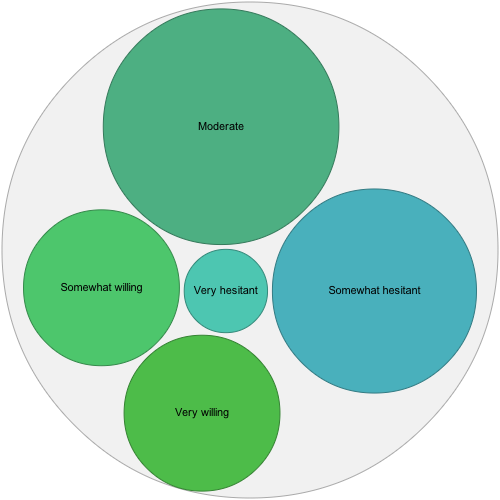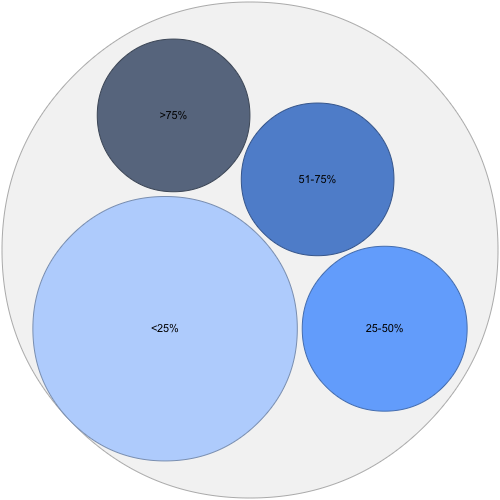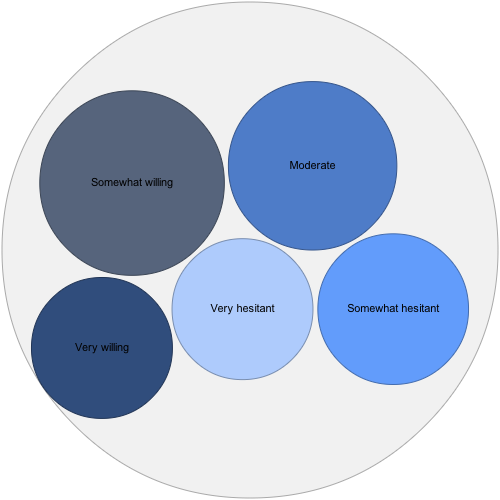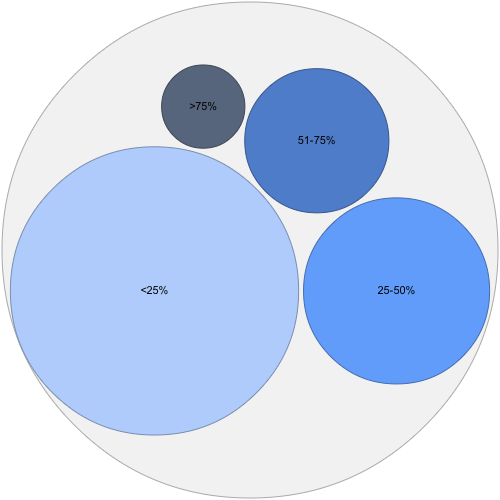TAACCCT & OER
Survey and analysis by Billy Meinke / Creative Commons
Building Communities of Practice in the Collaborative Construction of Open Educational Resources
 Project background
Project background
-
U.S. DOL Trade Adjustment Assistance for Community and Technical Colleges
(TAACCCT)
-
Open Educational Resources
(OER)
- Open Partners Educational Network (OPEN)
- Communities of Practice (CoP)
What is the TAACCCT program?

The largest investment in OER to date, funding the development of two-year technical training courses and programs to support training and job success in high-skill labor positions, serving unemployed and under-employed Americans.
US$2bn over 4 years | 183 grants | All materials CC BY
- Healthcare
- Information Technology
- Advanced Manufacturing
- Transportation
- Energy
Open Educational Resources (OER)
Learning and research resources that reside in the public domain or have been released with an open IP (copyright) license.
Courses, textbooks, assessment tools, support materials in useful technical formats for repurposing.
Open Partners Educational Network (OPEN)




Support with:
-
Open Educational Resources (OER) practices & policies
-
Creative Commons (CC) licensing
-
Universal Design for Learning (UDL) and Accessibility
-
Evidence-based online technology use
- Effective course and learning design
open4us.org 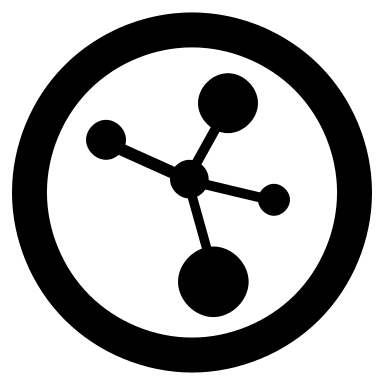

Communities of Practice (1/2)
"...a group of people that share a craft or profession."
Community of Practice (2/2)
Support | Discussion | Collaboration
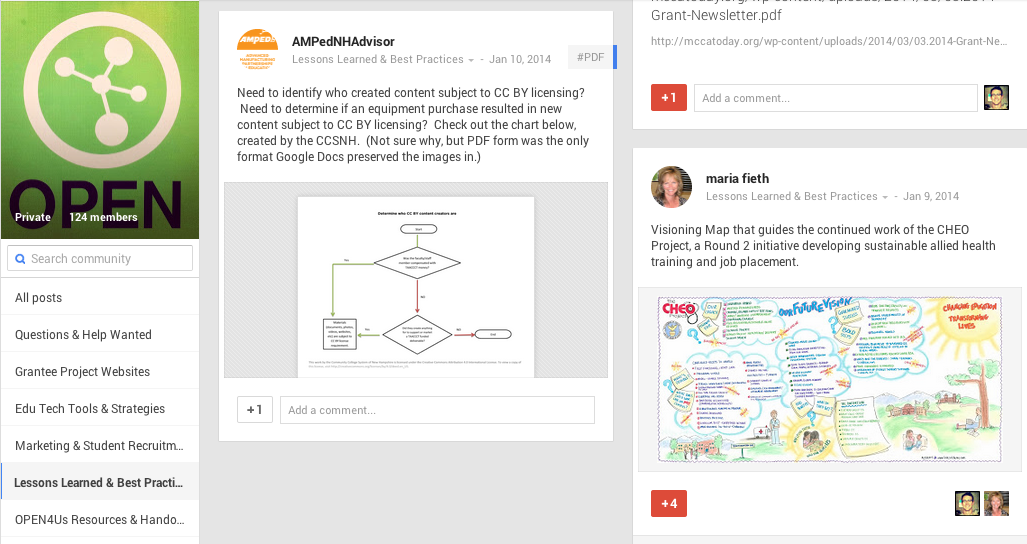
Private Google+ Community for grantees
A question
What do the hot spots of expertise in OER look like, and how does that relate to building courseware and programs together?
 Research focus
Research focus
OPEN services are designed to support grantees in their development of OER, and having better information about how grantees are interacting with OER is essential to inform both our practice and the OER movement.
What information about grantees would be useful in helping gauge their expertise with OER?
Guiding research
Barriers to OER (Plotkin, et al)
discoverability*
IP/copyright*
interoperability*
technology infrastructure*
culture of remixing*
multilingualism
Research question (1/2)
What knowledge and experience do TAACCCT project teams have with copyright and OER?
Research question (2/2)
What perceptions of quality and usability do grantees have of OER versus proprietary learning content?


OER Research Hub hypothesis
The open aspect of OER creates different usage and adoption patterns than other online resources
Fellowship with the OER Hub at The Open University (UK)
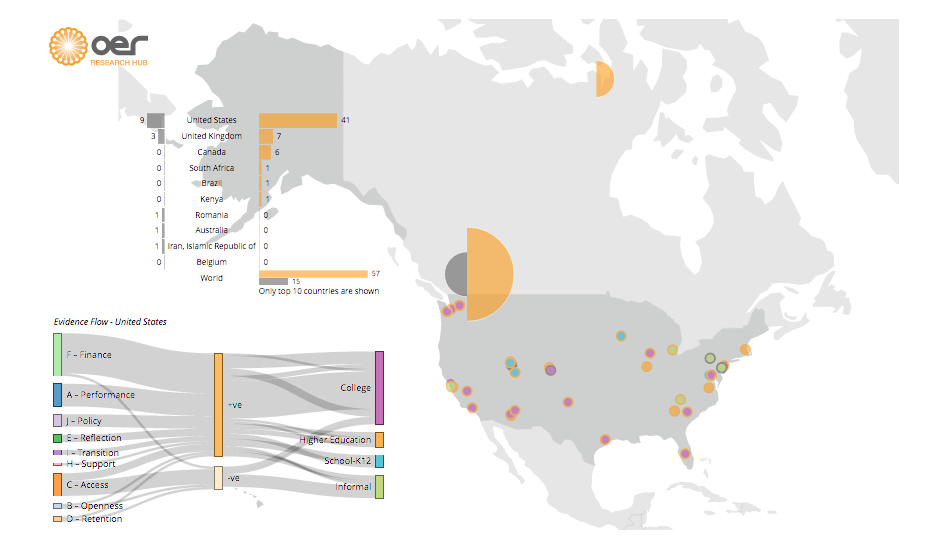
blog post after stay w/OER Hub
 Methods
Methods
Web-based Survey / Questionnaire:
- Survey design
- Data collection and cleaning
- Visualization and analysis
Survey (1/2)
Survey managed with Google Forms
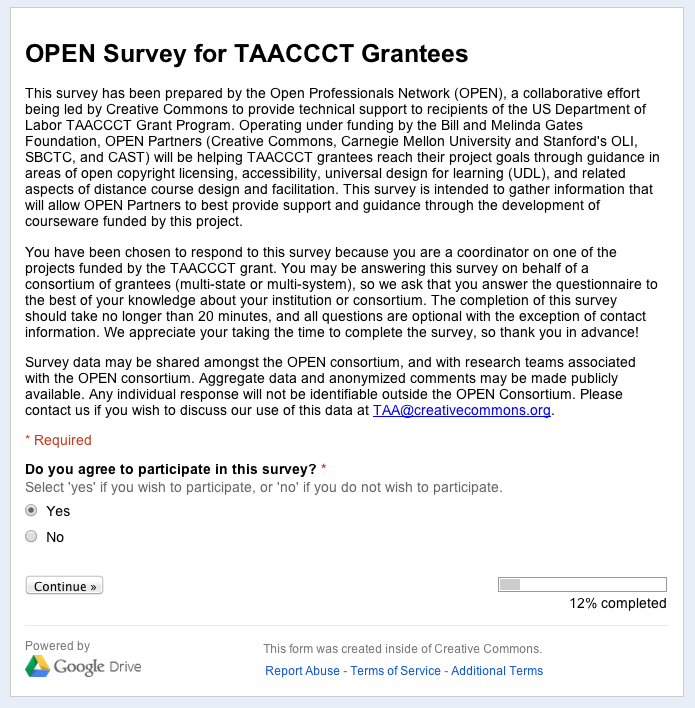
-
Link to form emailed to Round 1 & 2 TAACCCT Project Directors
-
Survey and questions optional, recorded only with opt-in
Survey (2/2)
(mostly) Free/open tools
Google spreadsheet > XLS
XLS (cleanup) > CSV
RAW app, OER Map> visualization
Visualization and analysis
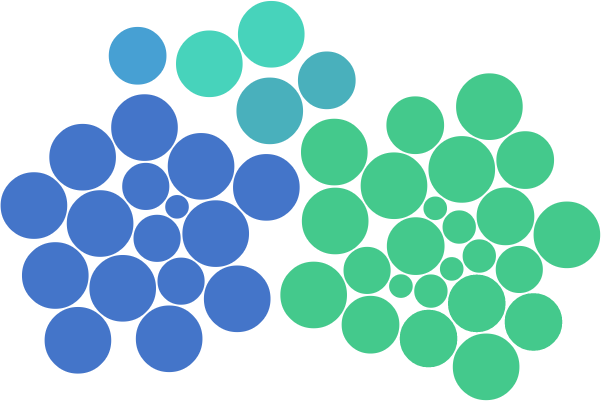
Note on Google form
Occasionally the form let respondents complete* it, but with no record
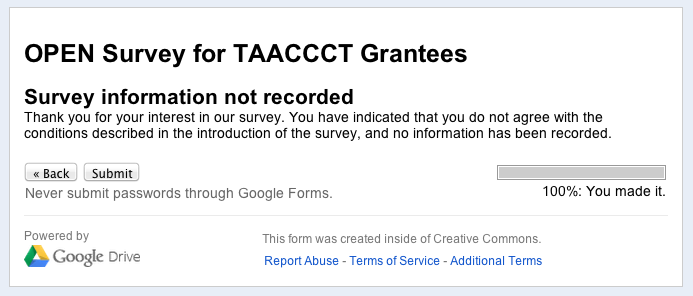
- 4 respondents reported a "not recorded" message
- columns of data missing from spreadsheet
- unreliable tool
*A response of "no" at first page was supposed to immediately directed visitors here
 Sample (N)
Sample (N)
51 responses recorded, representing 45 TAACCCT projects
5 duplicate respondents, 2 duplicate institutional responses
1 partially complete survey
(N=45)
See below for broad demographics
Project funding round
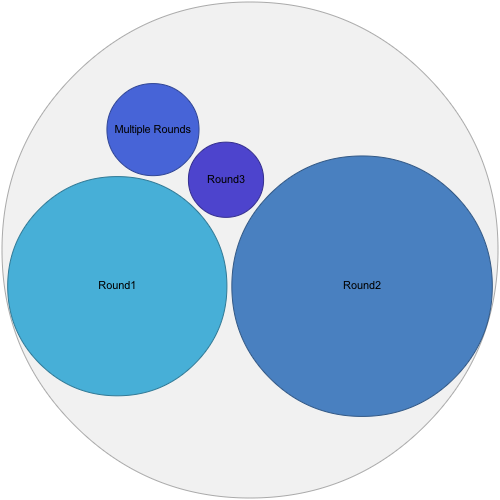
Grant funding round associated w/project (N=45)
Round1=35.6% (n=16), Round2=53.3% (n=24)
Round3=4.4% (n=2), Multiple Rounds=6.7% (n=3)
Stage of project development
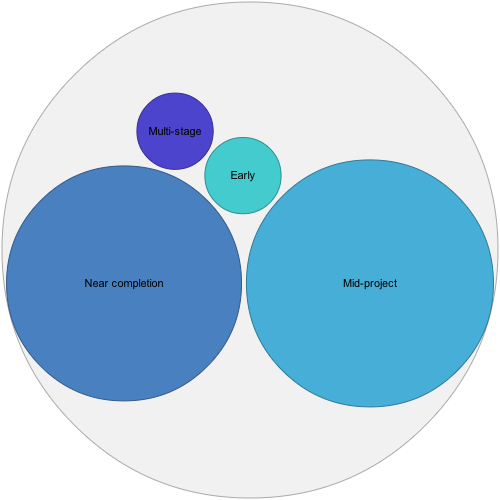
Stage of project development (N=44)
Early=4.5% (n=2), Mid-project=47.7% (n=21)
Near completion=43.2% (n=19), Multiple stages=4.5% (n=2)
Learning management systems (1/2)
Use of single or multiple LMS systems (N=45)
Single LMS=57.8% (n=26), Multiple LMSs=42.2% (n=19)
Learning management systems (2/2)
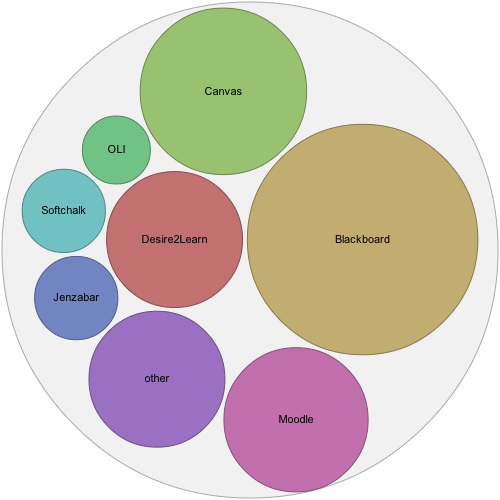
Frequencies of LMS systems in use (multiple selections possible)
Blackboard=51.1% (n=23), Canvas=26.7% (n=12), Moodle=17.8% (n=8)
Desire2Learn=17.8% (n=8), Jenzabar/OLI/Softchalk=6.7% (n=3) each,
other (1 indicated use, per)=17.8% (n=8)
 Survey results
Survey results
Themes of data collected:
- Awareness of OER, open licensing
- Experience with OER
- Perceptions of OER
- Use and perceptions of proprietary content
 data: Awareness of OER (3)
data: Awareness of OER (3)
Project team's current awareness of the following:
-
of Open Educational Resources (OER)
-
of open copyright licenses as a key component of OER
-
of the CC BY requirement for TAACCCT
data: Awareness of OER (1/3)
Portion of team aware of OER
(N=45)
None to few = 8.9% (n=4), About 25 percent=6.7% (n=3), About 50 percent=11.1% (n=5), About 75 percent=22.2% (n=10),
Nearly all=51.1% (n=23)
data: Awareness of OER (2/3)
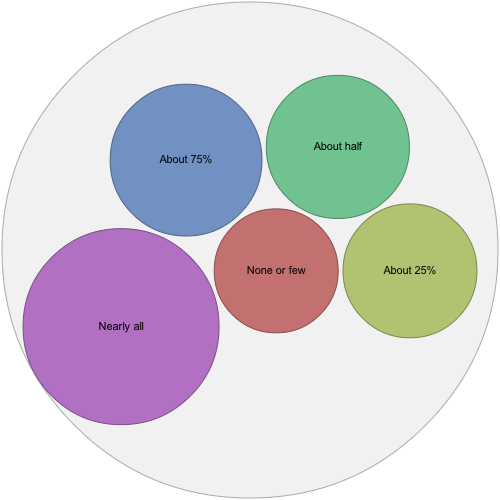
Awareness of open licensing as a key component of OER (N=45)
None to few = 13.3% (n=6), About 25 percent=15.6% (n=7),
About 50 percent=17.8% (n=8), About 75 percent=20.0% (n=9),
Nearly all=% (n=15)
data: Awareness of OER (3/3)
Portion of team aware of CC BY license requirement (N=45)
None to few = 6.7% (n=3), About 25 percent=8.9% (n=4),
About 50 percent=8.9% (n=4), About 75 percent=17.8% (n=8),
Nearly all=51.1% (n=23)
 data: Experience with OER (3)
data: Experience with OER (3)
Project team's experience with the following:
- release of OER prior to TAACCCT
- finding OER for use in TAACCCT
- amount of OER used in TAACCCT
data: Experience with OER (1/3)
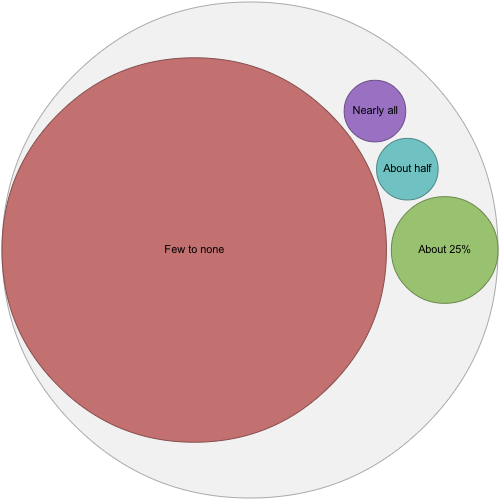
Portion of team having released OER prior to TAACCCT (N=44)
Few to none=88.6% (n=39), About 25 percent=6.8% (n=3),
About half=2.3% (n=1), Nearly all=2.3% (n=1)
data: Experience with OER (2/3)
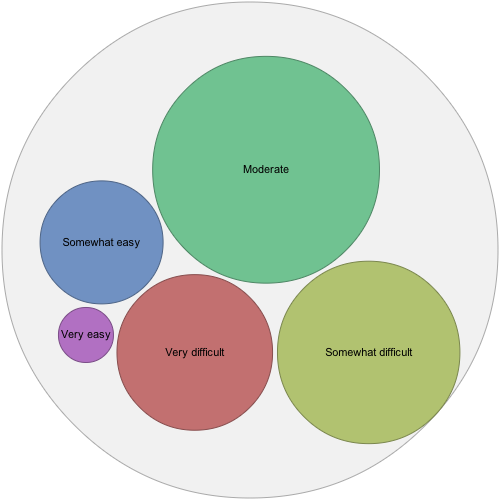
Team's experience finding relevant OER for course development (N=42)
Very difficult=19.0% (n=8), Somewhat difficult=26.2% (n=11),
Moderate=40.5% (n=17), Somewhat easy=11.9% (n=5),
Very easy=2.4% (n=1)
data: Experience with OER (3/3)
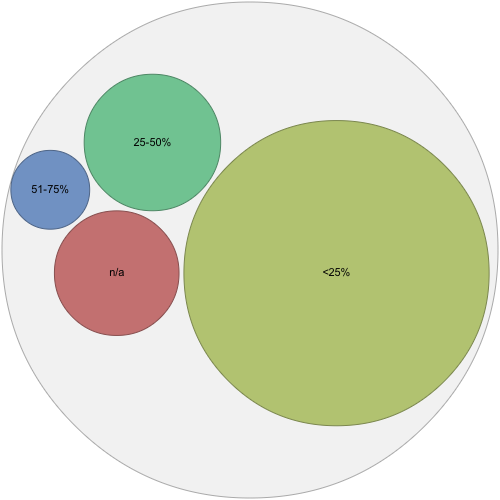
Portion OER used in project to date, March 2014 (N=43)
n/a=11.6% (n=5), <25 percent=70.7% (n=30), 25-50 percent=14.0% (n=6),
51-75 percent=4.7% (n=2)
 data: Perceptions of OER (3)
data: Perceptions of OER (3)
Project team's reporting of the following:
-
Willingness to use or adapt non-TAACCCT OER for project
-
Willingness to use or adapt existing TAACCCT OER for project
-
Planned usage of OER for TAACCCT course development
data: Perceptions of OER (1/3)
Willingness to use or adapt non-TAACCCT OER (N=44)
Very hesitant=9.1% (n=4), Somewhat hesitant=22.7% (n=10),
Moderate=27.3% (n=12), Somewhat willing=20.5% (n=9),
Very willing=20.5% (n=9)
data: Perceptions of OER (2/3)
Very hesitant=4.5% (n=2), Somewhat hesitant=27.3% (n=12),
Moderate=36.4% (n=16), Somewhat willing=15.9% (n=7),
Very willing=15.9% (n=7)
data: Perceptions of OER (3/3)
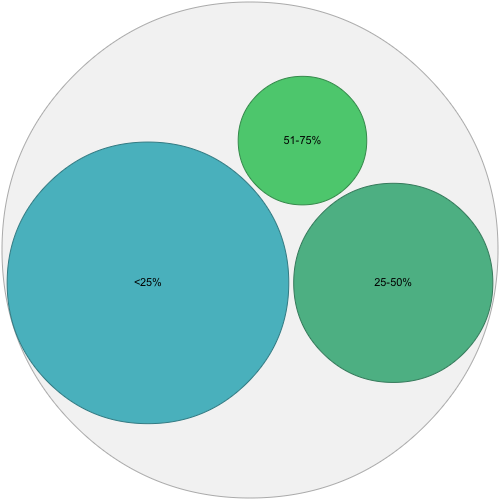
Planned usage of OER for TAACCCT course development (N=41)
<25 percent=58.5% (n=24), 25-50 percent=29.3% (n=12),
51-75 percent=12.2% (n=5)
 data: Use and perceptions of proprietary content (3)
data: Use and perceptions of proprietary content (3)
Project team's reporting about the following:
- Usage of proprietary content in TAACCCT project
- Planned usage of proprietary content in TAACCCT project
- Willingness to use proprietary content
- Willingness to adapt proprietary content
data: Use and perceptions of proprietary content (1/3)
<25 percent=50.0% (n=18), 25-50 percent=19.4% (n=7),
51-75 percent=16.7% (n=6), >75 percent=16.7% (n=6)
data: Use and perceptions of proprietary content (2/3)
Very hesitant=15.9% (n=7), Somewhat hesitant=18.2% (n=8),
Moderate=22.7% (n=10), Somewhat willing=27.3% (n=12),
Very willing=15.9% (n=7)
data: Use and perceptions of proprietary content (3/3)
<25 percent=57.1% (n=24), 25-50 percent=23.8% (n=10),
51-75 percent=14.3% (n=6), >75%=4.8% (n=2)
 Indicators and areas of exploration
Indicators and areas of exploration
Content types
Willingness to use or adapt content
Planned use of content
Funding rounds
Awareness of OER
Awareness of open licensing as a key component of OER
Willingness to reuse OER
Awareness of OER, copyright, licensing
Planned use vs. ability to locate useful OER
Past use vs. planned use of OER
Other
LMS vs. awareness of CC
Content: Willingness to use or adapt
OER | Proprietary
Similar distribution, slightly greater willingness to reuse OER across range of indicated preferences.
Content: Planned use
OER | Proprietary
Similar distribution (N=41, N=42), though greater intentions to use proprietary content across subgroups.
Funding Rounds: Awareness of OER
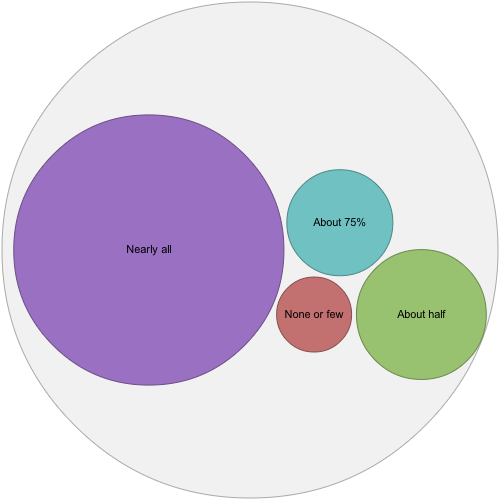
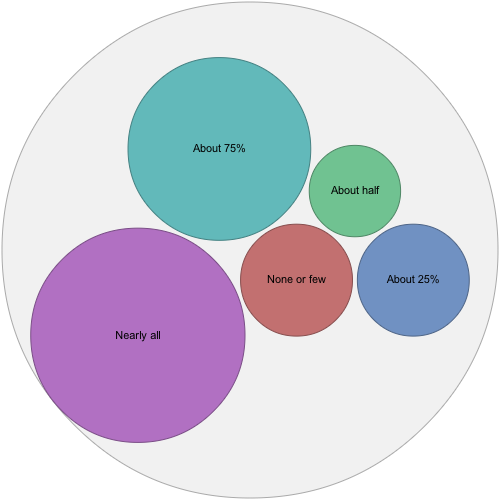
Round 1 | Round 2
Greater OER awareness in Round 1 (n=19), with broader distribution to awareness subgroups in Round 2 (n=24).
Willingness to use or adapt OER
non-TAACCCT OER | TAACCCT OER
Similar distribution, slightly greater willingness to reuse OER across range of indicated preferences.
OER: Planned use vs. ability to locate


Planned usage | Ability to locate
41.45% (n=17, N=41) indicated that 25-75 percent of content will be OER, while 45.2% (n=19, N=42) indicated a somewhat or very difficult experience locating OER for use in course development.
Current content usage breakdown
OER | Proprietary
Similar distribution (note that N=41, N=42), though greater intentions to use proprietary content across subgroups.
Technology and OER awareness
Ease of locating OER and willingness to use or adapt
 Discussion
Discussion
Attributions
Graph designed by Piotrek Chuchla from the Noun Project
Zoom designed by Liang Shi
from the
Noun Project
Comment designed by Srikanta from the Noun Project
Pie Chart designed by Simple Icons from the Noun Project
Layers designed by P.J. Onori from the Noun Project
Tools designed by Haridass from the Noun Project
Magnifying Glass designed by SimpleScott from the Noun Project
Magnifying Glass designed by SimpleScott from the Noun Project
TAACCCT & OER (draft)
By Billy Meinke
TAACCCT & OER (draft)
- 3,361
